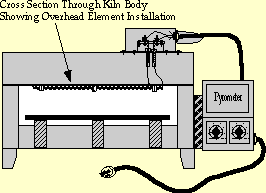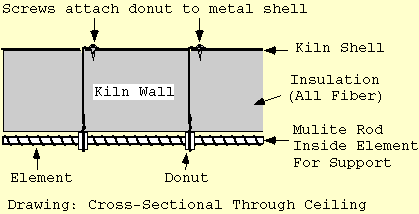
This system is especially useful when placing elements in an "all frax" kiln situation. When coupled with internal structure, (product named 30" MULITE RODS), this makes a great overhead installation. This is used in slumpers where it is preferred to set up the kiln and then place the lid (including the elements) on top. In this situation the heat enters evenly as though poured into the kiln from the top (radiates evenly onto the work). This is demonstrated in the kiln image below:


| Not every kiln situation needs internal mulite rods. If you are doing simple annealing, "donuts" alone are more than adequate. In this application (for simple annealing up to 950 degrees F) if you place the "donuts" every 6" to 8" along the element path, you will find this to be plenty of support. The great thing about this "donut" system is that it holds the element in place. Over the years the element will make countless expansions and contractions but it will be firmly held pat. Not so with the grooved brick situation. There, in time, the element will work itself loose and will have to be repinned. And one of those times when the repinning is going on, the pliers will slip and the element will snap. And that's when you will need to call Dudley for a reorder. I don't get many calls from the ones that use the "donut" system. |
 |
 |
The "Donut System" is best used along vertical walls, which provides some support. It is also more frequently used in all-frax construction, though it can be used in an (IFB) brick kiln. The "donuts" should be placed "one above the other." This allows for the natural slump of the element to occur without the elements touching another element or the insulator attachment wires. The elements simply hang in tandem. Please note this type of installation is for use in annealing situations only. The "donut system" is not suitable for use in slumping or casting kilns. Those situations require either the grooved brick construction shown previously, or the mulite rod structure, shown immediately above. |